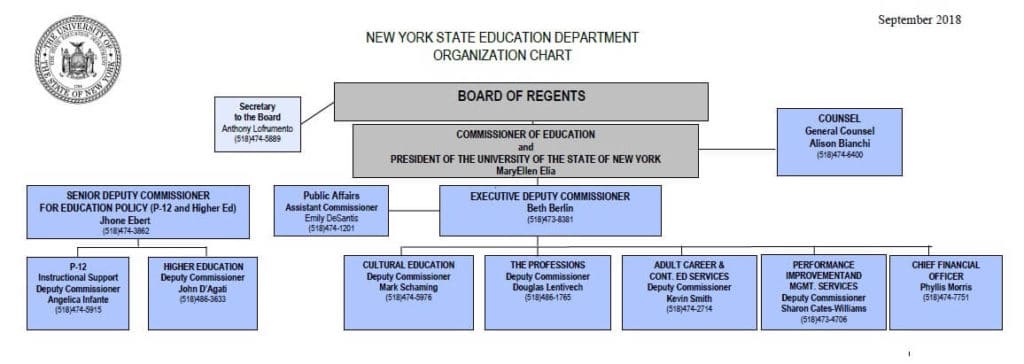NYS Education System
ORGANIZATION
Structure of the NYS Education System

At the top, we have The University of the State of NY.
It strives to maintain and improve education within New York State. It includes many organizations like museums, libraries, and schools. Its governing body is the New York State Board of Regents.
The New York State Board of Regents (the Regents) are responsible for the general supervision of all educational activities within the state, presiding over the University of the State of New York and the SED (State Education Department). The Regents’ regulations carry the same impact as laws enacted by the state legislature for public schools.
The Regents are a seventeen member volunteer board elected by the state legislature. They are appointed by the Speaker of the New York State Assembly and serve for a five-year term. The Regents include one member from each of the state’s thirteen judicial districts and four at-large members. The Regents elect their chancellor and appoint the Commissioner of Education.
Currently, Roger Tilles represents the Nassau-Suffolk region. Click the following link “Current Members of the Board of Regents” for a list of the current members.
Board of Regents:
- responsible for the general supervision of all educational activities in NYS
- meet once a month in Albany, New York to set education policy for the state
- serve on committees to discuss and make policy recommendations
- has a chancellor who oversees the board
NYSED carries out the policies set by the Board of Regents. It also supervises our public schools and education in the state and creates its own policies and rules.
SED has the following main branches each under the direction of the Commissioner of Education, MaryEllen Elia.
- Office of P-12 Education (P12), The Office of P-12 Education, oversees pre-K through 12th-grade programs. The division has diverse responsibilities, including: Accountability; State Assessment; Curriculum, Assessment, and Educational Technology; Information and Reporting Services; School Innovation; School Operations; Special Education; and implementing the Regents Education Reform Plan and New York State’s Race to the Top(RTTT) initiatives.
- Office of Higher Education
- Office of Cultural Education
- Office of Performance Improvement and Management Services
- Chief Financial Office
- Office of Counsel
- Office of the Professions
- Office of Adult Career and Continuing Education Services
Local school boards (also known as boards of education), are elected by the community members of the school district the town oversees.
School boards are responsible for:
employing the superintendent
developing and adopting policies, curriculum, and the budget;
overseeing facilities issues; and
adopting collective bargaining agreements.
Read more about school boards here


